The global micro-perforated food packaging market is anticipated to expand from USD 2 billion in 2025 to approximately USD 3.5 billion by 2035, recording an absolute increase of USD 1.54 billion over the forecast period. This translates into a total growth of 78.6%, with the market forecast to expand at a compound annual growth rate (CAGR) of 5.9% between 2025 and 2035. The market size is expected to grow by nearly 1.78X during the same period, supported by increasing consumer demand for fresh produce, rising awareness about food waste reduction, and growing adoption of modified atmosphere packaging technologies.
Between 2025 and 2030, the micro-perforated food packaging market is projected to expand from USD 2 billion to USD 2.6 billion, resulting in a value increase of USD 0.6 billion, which represents 41.6% of the total forecast growth for the decade. This phase of growth will be shaped by rising consumer awareness about food preservation benefits, increasing demand for green packaging solutions, and growing penetration of premium fresh food products in emerging markets. Food packaging companies are expanding their micro-perforated product portfolios to address the growing demand for extended shelf-life solutions.
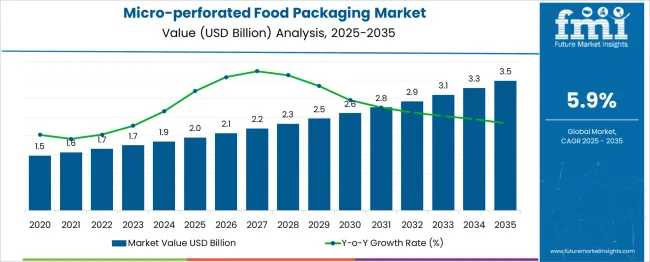
| Metric | Value |
| Estimated Value in (2025E) | USD 2 billion |
| Forecast Value in (2035F) | USD 3.5 billion |
| Forecast CAGR (2025 to 2035) | 5.9% |
From 2030 to 2035, the market is forecast to grow from USD 2.6 billion to USD 3.5 billion, adding another USD 0.9 billion, which constitutes 58.4% of the ten-year expansion. This period is expected to be characterized by expansion of e-commerce food delivery channels, integration of smart packaging technologies in micro-perforated films, and development of biodegradable micro-perforated solutions. The growing adoption of green packaging trends and food safety regulations will drive demand for premium micro-perforated food packaging with enhanced barrier properties and environmental compatibility.
Between 2020 and 2025, the micro-perforated food packaging market experienced steady expansion, driven by increasing consumer focus on fresh food quality and growing awareness of food waste reduction. The market developed as packaging manufacturers recognized the need for effective respiration control solutions to extend shelf life of perishable products. Supply chain optimization and retail sector growth began emphasizing the importance of micro-perforated packaging in maintaining product freshness during transportation and storage.
Market expansion is being supported by the increasing consumer demand for fresh, quality food products and the corresponding need for packaging solutions that maintain product integrity throughout the supply chain. Modern consumers are increasingly focused on healthy eating habits and eco-friendly food consumption practices that require effective preservation technologies. Micro-perforated packaging's proven efficacy in controlling respiration rates and preventing moisture buildup makes it a preferred solution for fresh produce packaging applications.
The growing focus on food waste reduction and green packaging is driving demand for micro-perforated films that extend product shelf life while maintaining environmental compatibility. Consumer preference for convenience foods that retain freshness and nutritional value is creating opportunities for innovative packaging designs. The rising influence of e-commerce food delivery and subscription services is also contributing to increased adoption of protective packaging solutions across different product categories and market segments.
The market is segmented by material, application, and region. By material, the market is divided into PE, PP, PET, and others. Based on application, the market is categorized into fruits & vegetables, bakery & confectionery, ready-to-eat, and others. Regionally, the market is divided into North America, Europe, East Asia, South Asia & Pacific, Latin America, and Middle East & Africa.
The PE material segment is projected to account for 55% of the micro-perforated food packaging market in 2025, reaffirming its position as the category's dominant material choice. Consumers and manufacturers increasingly prefer PE films due to their excellent moisture barrier properties, flexibility, and cost-effectiveness in large-scale production applications. PE's well-documented compatibility with food contact requirements directly addresses safety concerns while providing optimal gas transmission rates for fresh produce packaging.
This material forms the foundation of most micro-perforated packaging solutions, as it represents the most versatile and processing-friendly option for converting operations. Industry certifications and regulatory approvals continue to strengthen confidence in PE-based micro-perforated films. With packaging requirements demanding both performance and economic efficiency, PE materials align with both functional and commercial objectives. Their broad compatibility across different perforation technologies ensures market dominance, making them the central growth driver of micro-perforated food packaging demand.
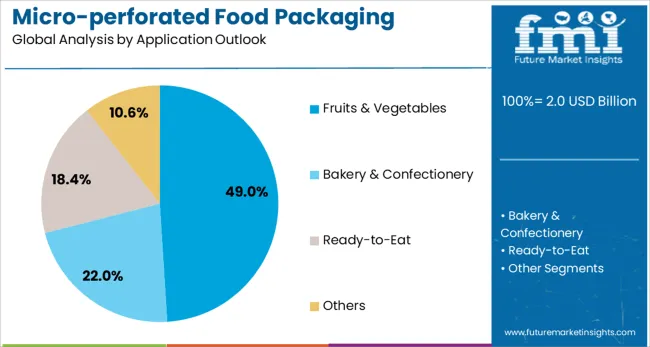
Fruits & vegetables applications are projected to represent 49% of micro-perforated food packaging demand in 2025, underscoring their role as the primary application driving market growth. Fresh produce requires precise respiration control to maintain quality, extend shelf life, and prevent spoilage during transportation and retail display. Micro-perforated films provide optimal gas exchange rates that match the respiratory requirements of different fruits and vegetables, maximizing product freshness and reducing waste.
The segment is supported by the rising popularity of healthy eating trends, where fresh produce plays a central role in consumer dietary preferences. The retailers are increasingly adopting premium packaging solutions that enhance product presentation while maintaining quality standards. As health-conscious consumers prioritize fresh, nutritious foods, micro-perforated packaging for fruits and vegetables will continue to dominate market demand, reinforcing the critical role of specialized packaging in fresh food supply chains.
The micro-perforated food packaging market is advancing steadily due to increasing consumer demand for fresh food products and growing awareness about food waste reduction. The market faces challenges including raw material price volatility, perforation technology limitations, and competition from alternative preservation methods. Innovation in biodegradable materials and smart packaging integration continue to influence product development and market expansion patterns.
The expanding adoption of e-commerce platforms for food delivery and online grocery shopping is creating new demand for protective packaging solutions that maintain product quality during extended transportation periods. Online channels require packaging that can withstand handling stress while preserving product freshness and presentation. Micro-perforated packaging provides the necessary protection and respiration control for perishable items in e-commerce supply chains.
Modern micro-perforated packaging manufacturers are incorporating natural materials and developing biodegradable alternatives to address environmental concerns and regulatory requirements. These innovations focus on maintaining packaging performance while reducing environmental impact through compostable films and recycled content integration. Eco-friendly packaging solutions also enable brands to meet consumer expectations for environmentally responsible packaging choices.
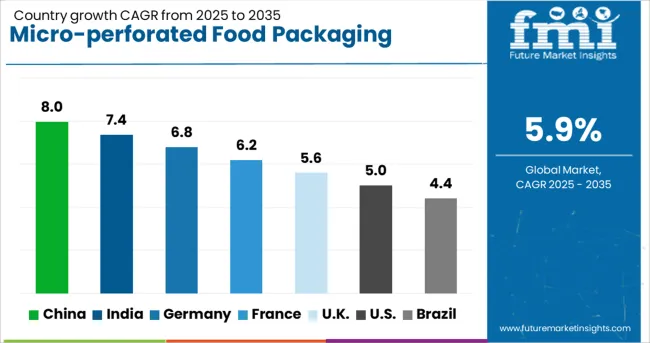
| Country | CAGR (2025-2035) |
| China | 8.0% |
| India | 7.4% |
| Germany | 6.8% |
| France | 6.2% |
| UK | 5.6% |
| USA | 5.0% |
| Brazil | 4.4% |
The micro-perforated food packaging market is experiencing robust growth globally, with China leading at an 8.0% CAGR through 2035, driven by rapid urbanization, expanding fresh food retail networks, and increasing consumer awareness about food quality and safety. India follows closely at 7.4%, supported by growing middle-class population, rising disposable income, and expanding organized retail sector. Germany shows steady growth at 6.8%, emphasizing technological innovation and packaging solutions. France records 6.2%, focusing on premium food packaging and culinary excellence. The UK shows 5.6% growth, prioritizing food waste reduction.
The report covers an in-depth analysis of 40+ countries; seven top-performing countries are highlighted below.
Revenue from micro-perforated food packaging in China is projected to exhibit strong growth with a CAGR of 8.0% through 2035, driven by rapid expansion of fresh food retail chains and increasing consumer demand for quality preservation solutions. The country's robust manufacturing capabilities and growing middle-class population are creating significant demand for advanced packaging technologies. Major domestic and international packaging manufacturers are establishing comprehensive production facilities to serve the expanding fresh food market across tier-1 and tier-2 cities.
Revenue from micro-perforated food packaging in India is expanding at a CAGR of 7.4%, supported by rapid urbanization, growing organized retail sector, and increasing consumer awareness about food quality and safety. The country's expanding middle class and changing dietary preferences toward fresh, healthy foods are driving demand for advanced packaging solutions. International packaging companies and domestic manufacturers are establishing distribution networks to serve the growing fresh food retail market.
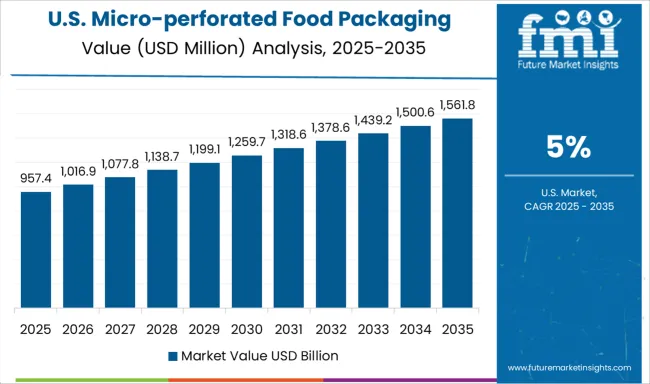
Demand for micro-perforated food packaging in the USA is projected to grow at a CAGR of 5.0%, supported by consumer preference for green packaging solutions and innovative food preservation technologies. American consumers are increasingly focused on food waste reduction, product freshness, and environmentally responsible packaging choices. The market is characterized by strong demand for premium packaging solutions that combine performance with environmental compatibility.
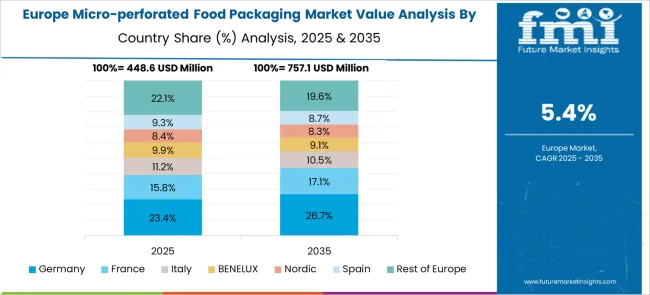
Revenue from micro-perforated food packaging in Germany is projected to grow at a CAGR of 6.8% through 2035, driven by the country's strong focus on packaging technology innovation, quality engineering, and consumer preference for premium food preservation solutions. German manufacturers consistently demand high-quality, precisely engineered packaging that delivers optimal performance while maintaining environmental responsibility.
Revenue from micro-perforated food packaging in France is projected to grow at a CAGR of 6.2% through 2035, supported by the country's strong culinary traditions and consumer appreciation for food quality and presentation. French consumers value packaging solutions that preserve food integrity, maintain nutritional value, and enhance product presentation throughout the supply chain.
Revenue from micro-perforated food packaging in the UK is projected to grow at a CAGR of 5.6% through 2035, supported by government initiatives promoting food waste reduction and consumer demand of natural packaging solutions. British retailers and consumers prioritize packaging technologies that extend product shelf life while minimizing environmental impact.
Revenue from micro-perforated food packaging in Brazil is projected to grow at a CAGR of 4.4% through 2035, supported by expanding organized retail sector, growing urban population, and increasing consumer awareness about food quality and safety. Brazilian consumers are increasingly adopting packaged fresh foods as urbanization and lifestyle changes drive demand for convenient, quality food options.
The micro-perforated food packaging market in Europe demonstrates mature development across major economies with Germany showing strong presence through its advanced packaging technology sector and consumer appreciation for quality food preservation solutions, supported by manufacturers leveraging engineering expertise to develop precise micro-perforated films that optimize fresh produce shelf life and maintain nutritional value throughout distribution channels.
France represents a significant market driven by its culinary heritage and sophisticated understanding of food quality maintenance, with companies pioneering premium micro-perforated packaging solutions that combine French food culture appreciation with advanced preservation technologies for enhanced product presentation and extended shelf life. The UK exhibits considerable growth through its focus on food waste reduction initiatives and green packaging adoption, with retailers and manufacturers embracing micro-perforated solutions as part of comprehensive waste reduction strategies.
Italy and Spain show expanding interest in fresh produce packaging solutions, particularly for Mediterranean fruits and vegetables that require specialized respiration control. BENELUX countries contribute through their advanced logistics networks and premium food retail sectors, while Eastern Europe and Nordic regions display growing potential driven by increasing fresh food consumption and expanding retail infrastructure across diverse market segments.
The Japanese micro-perforated food packaging market demonstrates steady growth driven by precision manufacturing focus, advanced packaging technologies, and consumer preference for high-quality food preservation systems ensuring superior product freshness and safety compliance throughout supply chain operations. International companies establish presence through cutting-edge micro-perforation technologies aligning with Japan's sophisticated food industry and stringent quality standards while incorporating smart packaging innovations and automated preservation capabilities.
The market emphasizes automated quality control systems, precision perforation excellence, and advanced material innovations reflecting Japanese manufacturing precision and attention to detail in food packaging processes. Growing investment in green packaging technologies supports intelligent preservation systems with real-time monitoring, predictive analytics, and optimized packaging performance. Japanese consumers prioritize product reliability, consistent preservation outcomes, and natural solutions, creating opportunities for premium micro-perforated packaging across fresh produce and specialty food applications.
The South Korean micro-perforated food packaging market shows exceptional growth potential driven by expanding food retail industry, increasing adoption of advanced packaging technologies, and growing consumer demand for fresh, quality food products requiring efficient and innovative preservation solutions. The market benefits from South Korea's technological advancement capabilities and increasing focus on food safety competitiveness driving investment in modern micro-perforation technologies meeting international quality standards and regulatory requirements.
Korean food manufacturers increasingly adopt automated packaging systems, precision perforation equipment, and integrated preservation technologies improving food quality maintenance and shelf life extension while ensuring safety compliance. Growing influence of Korean food culture in global markets supports demand for sophisticated micro-perforated packaging ensuring product freshness while maintaining cost-effectiveness. Integration of smart packaging principles creates opportunities for intelligent preservation systems with IoT connectivity, predictive freshness monitoring, and real-time quality optimization across diverse fresh food applications.
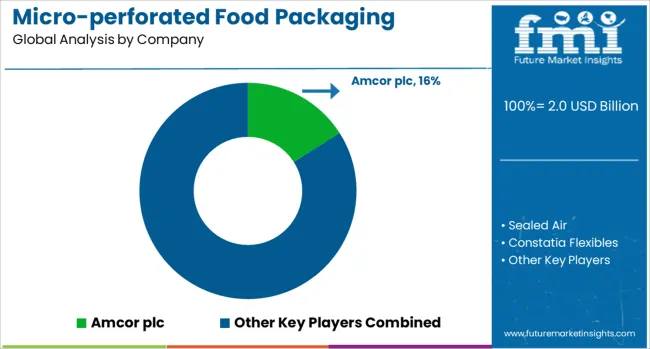
The micro-perforated food packaging market is characterized by competition among established packaging manufacturers, specialty film producers, and emerging green packaging companies. Companies are investing in advanced perforation technologies, natural material development, precision manufacturing capabilities, and supply chain integration to deliver effective, innovative, and environmentally responsible packaging solutions. Technology leadership, material innovation, and customer partnership are central to strengthening market position and expanding application opportunities.
Amcor plc leads the market with 16.0% global value share, offering comprehensive micro-perforated packaging solutions with focus on precision perforation technology and natural material options. Sealed Air provides innovative packaging systems that combine micro-perforation with modified atmosphere packaging for enhanced preservation performance. Constantia Flexibles delivers specialized films with customized perforation patterns for specific application requirements. Uflex Limited focuses on cost-effective solutions with broad application versatility across different market segments.
Huhtamaki focus green packaging development with recyclable and biodegradable micro-perforated options. A·ROO Company specializes in precision laser perforation technology for premium applications. Specialty Polyfilms provides customized film solutions with optimized gas transmission properties. Prism Pak, Inc. focuses on innovative perforation patterns and material combinations. Greendot Biopak develops biodegradable alternatives for environmentally conscious applications. Crystal Vision Packaging offers comprehensive packaging systems with integrated perforation solutions.
| Items | Values |
| Quantitative Units (2025) | USD 2 billion |
| Material | PE, PP, PET, Others |
| Application | Fruits & vegetables, Bakery & confectionery, Ready-to-eat, Others |
| Regions Covered | North America, Europe, East Asia, South Asia & Pacific, Latin America, Middle East & Africa |
| Countries Covered | United States, Canada, United Kingdom, Germany, France, China, Japan, South Korea, India, Brazil, Australia and 40+ countries |
| Key Companies Profiled | Amcor plc, Sealed Air, Constantia Flexibles, Uflex Limited, Huhtamaki, A·ROO Company, Specialty Polyfilms, Prism Pak Inc., Greendot Biopak ., and Crystal Vision Packaging, Sev-Rend, PerfoTec, KM Packaging Services Ltd. |
| Additional Attributes | Dollar sales by material type and perforation technology, regional demand trends, competitive landscape, buyer preferences for natural versus conventional materials, integration with smart packaging technologies, innovations in biodegradable films, precision perforation methods, and supply chain optimization |
North America
Europe
East Asia
South Asia & Pacific
Latin America
Middle East & Africa
The global micro-perforated food packaging market is estimated to be valued at USD 2.0 billion in 2025.
The market size for the micro-perforated food packaging market is projected to reach USD 3.5 billion by 2035.
The micro-perforated food packaging market is expected to grow at a 5.9% CAGR between 2025 and 2035.
The key product types in micro-perforated food packaging market are pe, pp, pet and others.
In terms of application outlook, fruits & vegetables segment to command 49.0% share in the micro-perforated food packaging market in 2025.






Our Research Products

The "Full Research Suite" delivers actionable market intel, deep dives on markets or technologies, so clients act faster, cut risk, and unlock growth.

The Leaderboard benchmarks and ranks top vendors, classifying them as Established Leaders, Leading Challengers, or Disruptors & Challengers.

Locates where complements amplify value and substitutes erode it, forecasting net impact by horizon

We deliver granular, decision-grade intel: market sizing, 5-year forecasts, pricing, adoption, usage, revenue, and operational KPIs—plus competitor tracking, regulation, and value chains—across 60 countries broadly.

Spot the shifts before they hit your P&L. We track inflection points, adoption curves, pricing moves, and ecosystem plays to show where demand is heading, why it is changing, and what to do next across high-growth markets and disruptive tech

Real-time reads of user behavior. We track shifting priorities, perceptions of today’s and next-gen services, and provider experience, then pace how fast tech moves from trial to adoption, blending buyer, consumer, and channel inputs with social signals (#WhySwitch, #UX).

Partner with our analyst team to build a custom report designed around your business priorities. From analysing market trends to assessing competitors or crafting bespoke datasets, we tailor insights to your needs.
Supplier Intelligence
Discovery & Profiling
Capacity & Footprint
Performance & Risk
Compliance & Governance
Commercial Readiness
Who Supplies Whom
Scorecards & Shortlists
Playbooks & Docs
Category Intelligence
Definition & Scope
Demand & Use Cases
Cost Drivers
Market Structure
Supply Chain Map
Trade & Policy
Operating Norms
Deliverables
Buyer Intelligence
Account Basics
Spend & Scope
Procurement Model
Vendor Requirements
Terms & Policies
Entry Strategy
Pain Points & Triggers
Outputs
Pricing Analysis
Benchmarks
Trends
Should-Cost
Indexation
Landed Cost
Commercial Terms
Deliverables
Brand Analysis
Positioning & Value Prop
Share & Presence
Customer Evidence
Go-to-Market
Digital & Reputation
Compliance & Trust
KPIs & Gaps
Outputs
Full Research Suite comprises of:
Market outlook & trends analysis
Interviews & case studies
Strategic recommendations
Vendor profiles & capabilities analysis
5-year forecasts
8 regions and 60+ country-level data splits
Market segment data splits
12 months of continuous data updates
DELIVERED AS:
PDF EXCEL ONLINE
Food & Beverage OEE Software Market Size and Share Forecast Outlook 2025 to 2035
Food Grade Crosslinked Polyvinylpolypyrrolidone (PVPP) Market Size and Share Forecast Outlook 2025 to 2035
Food Grade Cassia Gum Powder Market Size and Share Forecast Outlook 2025 to 2035
Food Grade Dry Film Lubricant Market Size and Share Forecast Outlook 2025 to 2035
Foodservice Equipment Market Analysis - Size, Share, and Forecast Outlook 2025 to 2035
Food Basket Market Forecast and Outlook 2025 to 2035
Food Grade Tremella Polysaccharide Market Size and Share Forecast Outlook 2025 to 2035
Food Sorting Machine Market Size and Share Forecast Outlook 2025 to 2035
Foodservice Paper Bag Market Size and Share Forecast Outlook 2025 to 2035
Food Stabilizers Market Size and Share Forecast Outlook 2025 to 2035
Food Certification Market Size and Share Forecast Outlook 2025 to 2035
Food Tray Market Size and Share Forecast Outlook 2025 to 2035
Food & Beverage Industrial Disinfection and Cleaning Market Size and Share Forecast Outlook 2025 to 2035
Food Technology Market Size and Share Forecast Outlook 2025 to 2035
Food Tourism Sector Market Size and Share Forecast Outlook 2025 to 2035
Food Processing Boiler Market Size and Share Forecast Outlook 2025 to 2035
Food Minerals Market Size and Share Forecast Outlook 2025 to 2035
Food And Beverage Chemicals Market Size and Share Forecast Outlook 2025 to 2035
Food and Beverage Industry Software Market Size and Share Forecast Outlook 2025 to 2035
Food Can Coatings Market Size and Share Forecast Outlook 2025 to 2035

Thank you!
You will receive an email from our Business Development Manager. Please be sure to check your SPAM/JUNK folder too.
Chat With
MaRIA